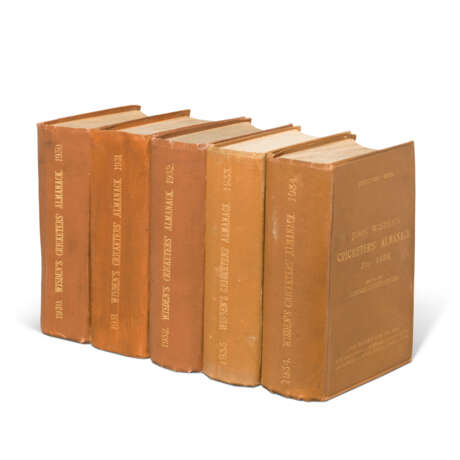ID 381406
Lot 198 | Wisden
Estimate value
£ 2 600 – 3 000
The 'Bodyline' Wisden. Run of Wisdens that contains the volume for 1934 with the full record, analysis and extensive comment on the MCC tour of Australia in 1932-1933, later known as the ‘Bodyline tour'. England's captain, Douglas Jardine, in an effort to stymie Donald Bradman's prodigious batting, developed 'Fast Leg Theory' in which England's fast bowlers, Harold Larwood and Bill Voce, bowled extremely fast, short-pitched balls that rose into the batsman's body, forcing a defensive stroke that would most probably lead to a catch from a fielder stationed in a closely-packed cordon on the leg side. In practice, this was an extremely dangerous tactic, and most Australian players sustained injuries from being hit by the ball. Incensed by what they perceived as a deliberate attempt to intimidate and injure their players, the Australian team, press and public unleashed a vitriolic attack on the English. Hampered by being unable to see any motion-picture footage, and the sheer distance between the two countries forcing communciation into a series of truncated telegrams and cables, the MCC at Lord's did not understand the dangers posed by 'Bodyline', and the English press and cricket authorities declared the Australians as sore losers. The 1934 almanack covers the tour and its repercussions. Larwood, acting under orders, was never to play for England again after refusing to apologise. Jardine was never asked to apologise, and yet it was he who instigated the strategy. It was only with the return of the English team and the subsequent use of Bodyline against English players in England by the touring West Indian cricket team in 1933 that demonstrated to the country the dangers it posed. The MCC subsequently revised the Laws of Cricket to prevent the use of 'fast leg theory' in the future.
5 volumes, octavo (160 x 102mm), each volume with a plate, and all bound in original publisher’s hardback cloth gilt, printed yellow endpapers (spines to 1930 and 1931 volumes lightly creased, the others in very good condition, with light rubbing to extremities).
| Address of auction |
CHRISTIE'S 8 King Street, St. James's SW1Y 6QT London United Kingdom | |
|---|---|---|
| Preview |
| |
| Phone | +44 (0)20 7839 9060 | |
| Buyer Premium | see on Website | |
| Conditions of purchase | Conditions of purchase |



